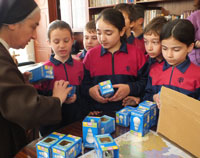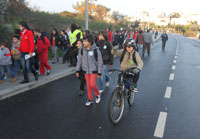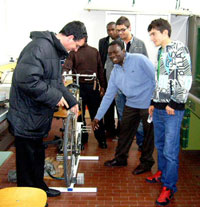In a class of their own: lessons in energy and education from European schools Inspire article
“If we don’t protect our environment, we won’t have one,” say Carolina, 13, from Portugal.

How far would you be willing to go to raise awareness amongst staff and students at your school of the need for sustainable energy?
You could get creative with the curricula. As a topic, energy efficiency lends itself to a host of disciplines, from easier fits like science, technology, engineering and mathematics (STEM subjects) right through to the humanities and arts: there are many approaches that teachers can be encouraged to take.

when you leave a room, and
use energy -saving light
bulbs. They not only use
less energy per hour, but
last up to 10 times longer
than incandescent bulbs
Image courtesy of the
European Commission
Biology lessons could look at the effects of pollution on the environment. Religious education might tackle the ethics of sustainability. You could engage with children’s creativity by producing journals, reports or works of art about sustainability.
But would you be willing to lobby your local mayor for support? Or take to the streets where you live with drums and banners or sandwich boards? Or travel to another continent to showcase sustainable-energy business models that you and your students have created together?

funded through the
Intelligent Energy Europe
programme of the European
Union
The challenge to get creative about sustainability was issued this year by the U4energy competitionw1, an initiative funded through the Intelligent Energy Europe programme of the European Union. A pan-European hunt was launched to recognise and reward exceptional efforts to promote energy efficiency in schools. The calibre of the entries certainly did not disappoint.
Among the exceptional projects identified by the campaign, there are several that deserve particular attention due to their originality and success.
As diverse and inventive as the children and teachers themselves, the winning projects share some key features and values. A common approach was to give the children a certain degree of freedom and responsibility, which encouraged fuller involvement and enthusiasm, as well as securing real learning outcomes.
Also, in all the projects, engagement with local communities – from parents and families to friends, local businesses, and in some cases, the local authorities – has extended reach and impact.
Save energy – main concern
“If you want to pass on a message to the adults, first pass it on to the young ones,” says Sister Claudia Zammit, headmistress of St Francis Primary School in Malta.

Francis Primary School in
Malta
Image courtesy of St Francis
Primary, Malta
Winner of the category for ‘best energy efficiency measures’, the St Francis ‘Save energy – main concern’ project has engaged youngsters from ages 5 to 11 in conservation with a raft of activities. From rotating teams of ‘auditors’ and ‘detectors’ monitoring energy waste, to poetry, song and craft workshops, and even appearances on national radio and TV, pupils there have embraced the concept of saving energy with enormous enthusiasm.
“I was even told by a little girl aged 7 to switch off my unused computer,” reports Sister Claudia.
A substantial drop of 20 % in energy consumption at the school was recorded last year, and effects logged by pupils at home attest to the reach of this project: “At home, we now use 2-3 units per day. My family is very happy because it used to be 5-10 units,” reported Nigel, aged 10.
Environmentally friendly school
Manuela Costa from Portugal also reports that pupils aged 3-15 at the Grouping of Schools of the City of Castelo Branco take the environment so seriously that she has noticed a role reversal, with pupils nagging the teachers about conservation.

friendly school’ project
spilled onto the streets with
‘walking and biking to
school’ days
Image courtesy of the
Grouping of Schools of the City
of Castelo Branco, Portugal
Manuela is the driving force behind Portugal’s ‘Environmentally friendly school’ project, an initiative that has so far touched the lives of 1000 students, staff, parents and members of the local community.
The project kicked off in 2010 when solar panels were installed right across the school. Today, water, electricity and waste ‘brigades’, made up of mixed groups of children from different years, patrol the school and report back to staff on their findings. All the pupils in the school have been involved in the project, and energy consumption across the school’s buildings dropped by 15 % as a result.

from a renewable source?
Image courtesy of the
European Commission
Enthusiasm like this was hard to contain within the confines of the school itself, which is why activities spilled over into the community with ‘walking and biking to school’ days, and a range of inventive awareness-building campaigns. One of the most enjoyable elements, for staff and pupils, was the involvement of the school percussion band, who quite literally took to the streets of Castelo Branco with banners and flyers to beat the drum for renewable energy.
Parents have had a key role too, and many have come in to talk about energy consumption in their workplaces. And such is the zeal of these pupils that mums and dads have reported being lobbied at home by children as young as three.
For Manuela, dedication like this begins in the classroom: “The key is to teach children from a very young age about renewable energy and the need to use it rationally.”
Energy work bike
Almerindo Capuani of the Alessandrini Marino Institute in Teramo, Italy, took a novel approach to mobilising students (aged 17-18) to think about sustainability, energy sources and development.

learning from the ‘Energy
work bike’ team how the
equipment works
Image courtesy of the Institute
of Higher Education
Alessandrini- Marino of
Teramo, Italy
The ‘Energy work bike’ project is an undertaking so inventive, so dynamic and so multifaceted that it defies simple definition. Part electrical engineering, part technology, part design and part philanthropy, this extraordinary scheme has seen students produce four prototypes of energy-producing bikes that can charge a mobile phone, sharpen work tools, power a laptop, or harness the Sun’s rays and convert them to electricity.
Two patents and a fully fledged business plan later, the whizz-kids from Teramo have travelled to the Butembo Mission in the Democratic Republic of Congo, where they met with monks and youngsters eager to find out how to replicate the bikes for energy and potentially for employment.
For Almerindo, the benefits and rewards of this project address a wide range of pedagogical, environmental and societal objectives: goals that for him and his colleagues were quite clear, if ambitious, from the start. “We wanted to address a range of diverse and complex elements when we began working on this. Inside the classroom we focused on integrating different subjects and disciplines from automatic electric systems to engineering,” he says.
“At the same time, we wanted to encourage students to address real-life issues that affect us as citizens: urban pollution, sustainability and world poverty. The students were also keen to play their part in making a difference: the energy produced is limited, and does not solve any problems in Italy, but in Butembo and in developing countries it can become part of a solution to many needs.”
European Schoolnet

European Schoolnetw2 is a network of 30 ministries of education in Europe and beyond. U4energy is the first pan-European competition on energy education organised by the European Commission and powered by European Schoolnet.
Top ten ways to reduce energy consumption
- Switch off electronic devices when you are not using them.
- Turn down the thermostat by one degree and save 300 kg of CO2 each year.
- Switch off lights when not in use.
- Insulate walls, roof and floors well.
- Use reflective panels behind heaters to reflect the warmth into the living spaces.
- When cooking, cover pots and pans with lids.
- Turn the tap off while soaping hands or brushing teeth.
- Invest in energy-efficient light bulbs.
- Position your radiators with care.
- Take short showers.
